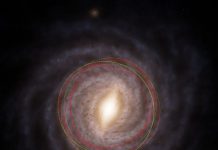
Exciting news from the world of astronomy!
A team of scientists led by Professor ZHAO Gang from the National Astronomical Observatories of the Chinese Academy of Sciences (NAOC) has found evidence that the Universe’s very first stars, known as ‘first stars,’ were even more massive than we thought.
This discovery came from studying a peculiar star named LAMOST J1010+2358, located in our own Milky Way galaxy.
When we look up at the night sky, we’re seeing stars of all different sizes, ages, and compositions.
The very first stars in the Universe, born shortly after the Big Bang, are thought to have been very different from the ones we see today.
They were massive, some possibly reaching hundreds of times the size of our Sun! Scientists believe that the largest of these first stars ended their lives in extraordinary explosions called pair-instability supernovae (PISNe).
This special type of supernova is different from the supernovae we’re more familiar with. They leave behind a unique chemical fingerprint, a sort of space-born signature. Up until now, no such signature had been discovered.
That all changed with the detection of LAMOST J1010+2358. This star has an odd mix of elements that suggests it was born from the remnants of a PISN.
Its most notable features are super-low levels of sodium and cobalt, much less than what we find in the Sun. There’s also an unusual difference between the amounts of certain other elements.
According to Dr. XING Qianfan, who played a key role in this research, the odd elemental mix found in this star matches up with what we would expect from a PISN caused by a first star with a whopping 260 times the mass of our Sun!
This finding is a big deal in the world of astrophysics. It helps confirm some theories about how these colossal stars could have developed and exploded. It also suggests that the second generation of stars that formed after these explosions might be more rich in metals than previously thought.
Before this discovery, we had no direct proof that such massive stars and their supernovae even existed. Now, we’ve got a clear sign, right there in the chemical makeup of a star in our own galaxy.
So next time you look up at the night sky, remember that those tiny points of light hold the secrets to some of the biggest mysteries of the Universe. And bit by bit, we’re uncovering those secrets.
What a time to be alive!



